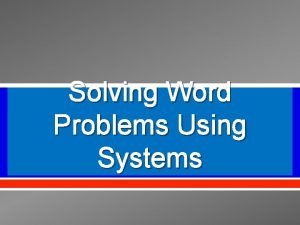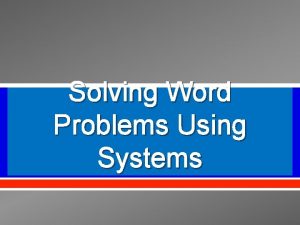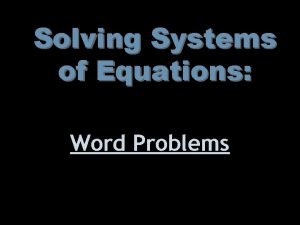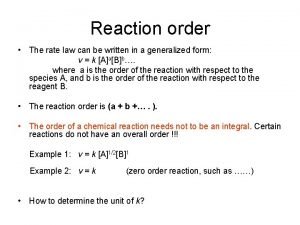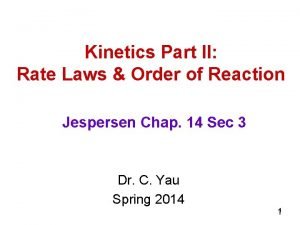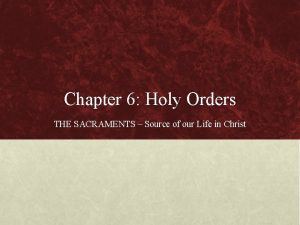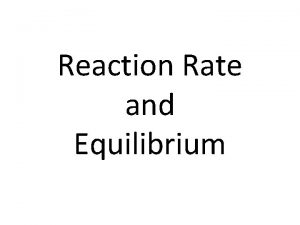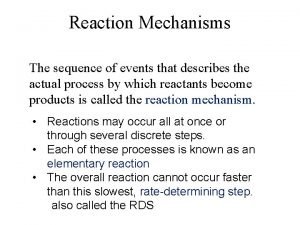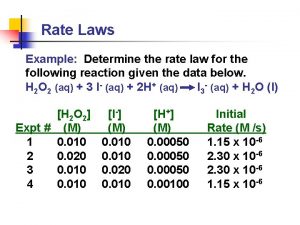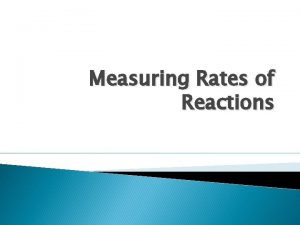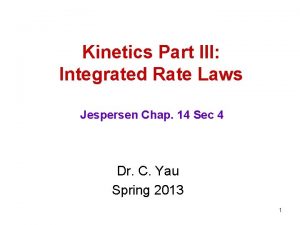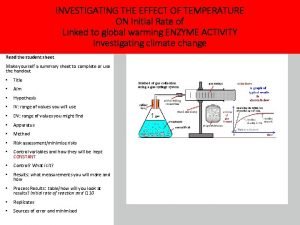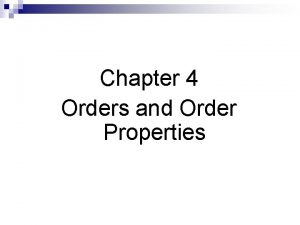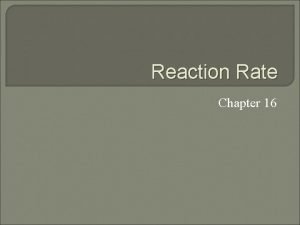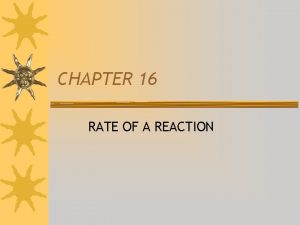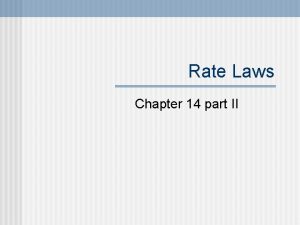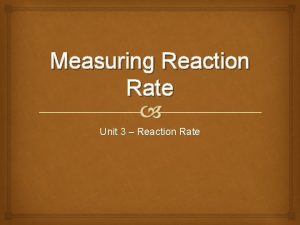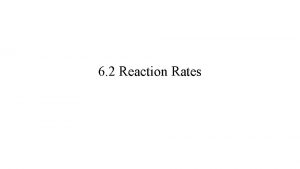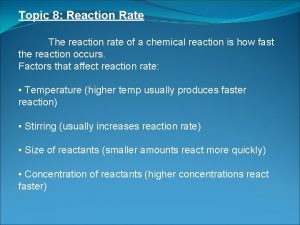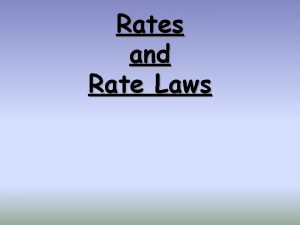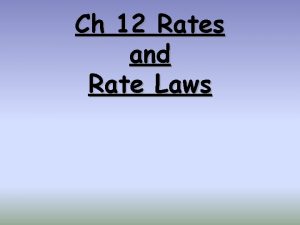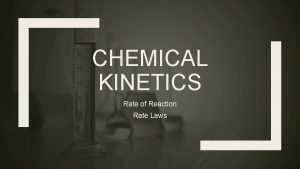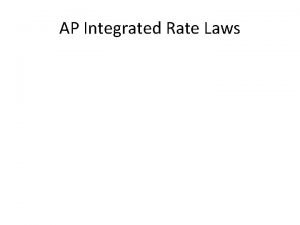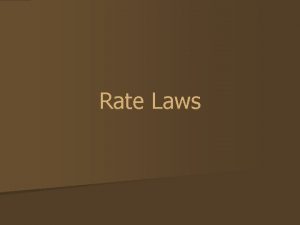Reaction Rate Orders Chapter 14 Rate Laws Review



![Integrated Rate Laws Manipulating this equation produces… [A]t ln [A]0 = −kt ln [A]t Integrated Rate Laws Manipulating this equation produces… [A]t ln [A]0 = −kt ln [A]t](https://slidetodoc.com/presentation_image_h2/846879ed0cb69c1c02336827c99d6f8e/image-4.jpg)
![First-Order Processes ln [A]t = -kt + ln [A]0 Therefore, if a reaction is First-Order Processes ln [A]t = -kt + ln [A]0 Therefore, if a reaction is](https://slidetodoc.com/presentation_image_h2/846879ed0cb69c1c02336827c99d6f8e/image-5.jpg)




![Half-Life For a first-order process, this becomes 0. 5 [A]0 ln = −kt 1/2 Half-Life For a first-order process, this becomes 0. 5 [A]0 ln = −kt 1/2](https://slidetodoc.com/presentation_image_h2/846879ed0cb69c1c02336827c99d6f8e/image-10.jpg)


![Second-Order Processes 1 1 = −kt + [A]t [A]0 So if a process is Second-Order Processes 1 1 = −kt + [A]t [A]0 So if a process is](https://slidetodoc.com/presentation_image_h2/846879ed0cb69c1c02336827c99d6f8e/image-13.jpg)

![Second-Order Processes • Graphing ln [NO 2] vs. t yields: • The plot is Second-Order Processes • Graphing ln [NO 2] vs. t yields: • The plot is](https://slidetodoc.com/presentation_image_h2/846879ed0cb69c1c02336827c99d6f8e/image-15.jpg)
![Second-Order Processes • Graphing ln 1/[NO 2] vs. t, however, gives this plot. Time Second-Order Processes • Graphing ln 1/[NO 2] vs. t, however, gives this plot. Time](https://slidetodoc.com/presentation_image_h2/846879ed0cb69c1c02336827c99d6f8e/image-16.jpg)
![Zeroth Order processes • [A] vs time when graphed creates straight line • The Zeroth Order processes • [A] vs time when graphed creates straight line • The](https://slidetodoc.com/presentation_image_h2/846879ed0cb69c1c02336827c99d6f8e/image-17.jpg)

- Slides: 18

Reaction Rate Orders Chapter 14

Rate Laws Review • The overall reaction order can be found by adding the exponents on the reactants in the rate law. Rate = k[A]m[B]n

Integrated Rate Laws Using calculus to integrate the rate law for a first-order process gives us Where [A]t ln [A]0 = −kt [A]0 is the initial concentration of A. [A]t is the concentration of A at some time, t, during the course of the reaction.
![Integrated Rate Laws Manipulating this equation produces At ln A0 kt ln At Integrated Rate Laws Manipulating this equation produces… [A]t ln [A]0 = −kt ln [A]t](https://slidetodoc.com/presentation_image_h2/846879ed0cb69c1c02336827c99d6f8e/image-4.jpg)
Integrated Rate Laws Manipulating this equation produces… [A]t ln [A]0 = −kt ln [A]t − ln [A]0 = − kt ln [A]t = − kt + ln [A]0 …which is in the form y = mx + b
![FirstOrder Processes ln At kt ln A0 Therefore if a reaction is First-Order Processes ln [A]t = -kt + ln [A]0 Therefore, if a reaction is](https://slidetodoc.com/presentation_image_h2/846879ed0cb69c1c02336827c99d6f8e/image-5.jpg)
First-Order Processes ln [A]t = -kt + ln [A]0 Therefore, if a reaction is first-order, a plot of ln [A] vs. t will yield a straight line, and the slope of the line will be -k.

First-Order Processes Consider the process in which methyl isonitrile is converted to acetonitrile. CH 3 NC CH 3 CN

First-Order Processes CH 3 NC This data was collected for this reaction at 198. 9°C. CH 3 CN

First-Order Processes • When ln P is plotted as a function of time, a straight line results. • Therefore, – The process is first-order. – k is the negative of the slope: 5. 1 10 -5 s− 1.

Half-Life • Half-life is defined as the time required for one-half of a reactant to react. • Because [A] at t 1/2 is one-half of the original [A], [A]t = 0. 5 [A]0.
![HalfLife For a firstorder process this becomes 0 5 A0 ln kt 12 Half-Life For a first-order process, this becomes 0. 5 [A]0 ln = −kt 1/2](https://slidetodoc.com/presentation_image_h2/846879ed0cb69c1c02336827c99d6f8e/image-10.jpg)
Half-Life For a first-order process, this becomes 0. 5 [A]0 ln = −kt 1/2 [A]0 ln 0. 5 = −kt 1/2 − 0. 693 = −kt 1/2 NOTE: For a first-order process, the half-life does not depend on [A]0. 0. 693 = t 1/2 k

Half Life • Since the half life is independent of the original concentration, half life of a first order reaction can be used as a representation of the rate constant because the half life and rate constant are inversely proportional to each other. – The shorter the half life, the faster the reaction rate – Real life examples of first order reactions: • Radioactive decay

Second-Order Processes Similarly, integrating the rate law for a process that is second-order in reactant A, we get 1 1 = −kt + [A]t [A]0 y = mx + b also in the form
![SecondOrder Processes 1 1 kt At A0 So if a process is Second-Order Processes 1 1 = −kt + [A]t [A]0 So if a process is](https://slidetodoc.com/presentation_image_h2/846879ed0cb69c1c02336827c99d6f8e/image-13.jpg)
Second-Order Processes 1 1 = −kt + [A]t [A]0 So if a process is second-order in A, a plot of 1/[A] vs. t will yield a straight line, and the slope of that line is k.

Second-Order Processes The decomposition of NO 2 at 300°C is described by the equation NO 2 (g) NO (g) + 1/2 O 2 (g) and yields data comparable to this: Time (s) 0. 0 50. 0 100. 0 [NO 2], M 0. 01000 0. 00787 0. 00649 200. 0 300. 00481 0. 00380
![SecondOrder Processes Graphing ln NO 2 vs t yields The plot is Second-Order Processes • Graphing ln [NO 2] vs. t yields: • The plot is](https://slidetodoc.com/presentation_image_h2/846879ed0cb69c1c02336827c99d6f8e/image-15.jpg)
Second-Order Processes • Graphing ln [NO 2] vs. t yields: • The plot is not a straight line, so the process is not first-order in [A]. Time (s) 0. 0 50. 0 100. 0 [NO 2], M 0. 01000 0. 00787 0. 00649 ln [NO 2] − 4. 610 − 4. 845 − 5. 038 200. 0 300. 00481 0. 00380 − 5. 337 − 5. 573
![SecondOrder Processes Graphing ln 1NO 2 vs t however gives this plot Time Second-Order Processes • Graphing ln 1/[NO 2] vs. t, however, gives this plot. Time](https://slidetodoc.com/presentation_image_h2/846879ed0cb69c1c02336827c99d6f8e/image-16.jpg)
Second-Order Processes • Graphing ln 1/[NO 2] vs. t, however, gives this plot. Time (s) 0. 0 50. 0 100. 0 [NO 2], M 0. 01000 0. 00787 0. 00649 1/[NO 2] 100 127 154 200. 0 300. 00481 0. 00380 208 263 • Because this is a straight line, the process is secondorder in [A].
![Zeroth Order processes A vs time when graphed creates straight line The Zeroth Order processes • [A] vs time when graphed creates straight line • The](https://slidetodoc.com/presentation_image_h2/846879ed0cb69c1c02336827c99d6f8e/image-17.jpg)
Zeroth Order processes • [A] vs time when graphed creates straight line • The negative slope is k • Reaction rate is independent of the concentration of a reactant – Changing its concentration has no effect on the speed of the reaction – Rate stays the constant

• The number of molecules involved in a collision can tell you the reaction rate order – Unimolecular reactions = first order – Bimolecular reactions = second order
 Casey orders 3 pizzas
Casey orders 3 pizzas Casey orders 3 pizzas
Casey orders 3 pizzas Casey orders 3 pizzas and 2 orders of breadsticks
Casey orders 3 pizzas and 2 orders of breadsticks Order of reaction
Order of reaction How to determine the rate law of a reaction
How to determine the rate law of a reaction Rate constant formula chemistry
Rate constant formula chemistry Facts about montesquieu
Facts about montesquieu Chapter review motion part a vocabulary review answer key
Chapter review motion part a vocabulary review answer key Chapter 6 holy orders study questions
Chapter 6 holy orders study questions Addition reaction and substitution reaction
Addition reaction and substitution reaction Leukoerythroblastic reaction vs leukemoid reaction
Leukoerythroblastic reaction vs leukemoid reaction Neutron emission
Neutron emission Equilibrium reaction rate
Equilibrium reaction rate Molecularity of reaction
Molecularity of reaction How to calculate rate of reaction
How to calculate rate of reaction Rate law
Rate law How to calculate instantaneous rate of reaction
How to calculate instantaneous rate of reaction Rate law for first order reaction
Rate law for first order reaction Inital rate
Inital rate
